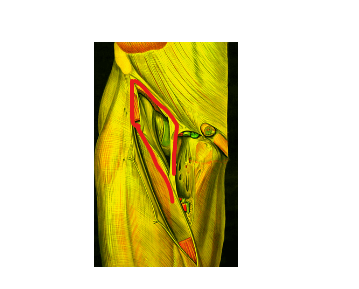Quick Overview
Femoral triangle is a triangular region in the upper thigh that is bounded by the inguinal ligament superiorly, the sartorius muscle medially, and the tensor fasciae latae muscle laterally.
The femoral triangle contains a number of important structures, including the femoral artery, vein, and nerve, as well as the lymphatic system.

Table of Contents
Anatomy of Femoral Triangle
The femoral triangle (also known as Scarpa’s triangle) is a wedge-shaped area formed by a depression between the muscles of the thigh. It is located on the medial aspect of the proximal thigh, just inferior to the inguinal ligament. It is clinically important region, as it contains the main blood vessels and nerves that supply the lower limb.
Read also Iliac Fossa and Anterior Cranial Fossa
Location
It is situated in the anterior aspect of the thigh, just below the inguinal ligament. Its precise location varies slightly from person to person but is generally found midway between the hip and the knee.
Boundaries
It is formed by the following structures;
- Superiorly: Inguinal ligament
- Medially: Sartorius muscle
- Laterally: Tensor fasciae latae muscle
Contents
This triangle contain the following structures;
- Femoral artery: The femoral artery is a large artery that supplies oxygenated blood to the thigh and leg.
- Femoral vein: The femoral vein is a large vein that drains deoxygenated blood from the thigh and leg.
- Femoral nerve: The femoral nerve is a large nerve that supplies motor and sensory function to the thigh and leg.
- Lymph nodes: This triangle contains a number of lymph nodes, which are part of the lymphatic system. The lymphatic system helps to fight infection.
- Fat and connective tissue: It also contains a significant amount of fat and connective tissue.
Lymph Nodes
The triangle contains a number of lymph nodes, which are part of the lymphatic system, and helps to fight against the infection. The lymph nodes in the femoral triangle drain lymph from the thigh and leg. Their examination can provide valuable insights into the health of the lower limb and pelvis.
Femoral Triangle Pain
Pain is a common complaint in this area and, can be caused by a number of things, which include;
1- Femoral artery aneurysm: A femoral artery aneurysm is a bulge in the femoral artery. It can cause pain in this area, as well as other symptoms such as pulsation in the thigh and difficulty walking.
2- Femoral nerve compression: Femoral nerve compression can occur when the femoral nerve is compressed by surrounding structures. It can also cause pain in the triangle, as well as other symptoms such as numbness and weakness in the thigh and leg.
3- Femoral triangle hernia: Hernia is a bulge of tissue through the femoral canal. It can cause pain in this area, as well as other symptoms such as a lump in the groin and difficulty walking.
4- Femoral triangle abscess: Abscess is a collection of pus in the triangle. It can cause pain in this region, as well as other symptoms such as fever and swelling.
Diagnosis
The pain is typically diagnosed based on a physical examination and medical history. Imaging tests, such as an ultrasound, CT scan, or MRI, may be ordered to confirm the diagnosis and assess the severity of the condition.
Treatment
The treatment for the triangle pain depends on the underlying cause. Common treatment options may include;
- Surgery for aneurysm, hernia
- Physical therapy for compressed nerves.
- Drainage of the abscess and antibiotics.
Question
Q: What are the risks of femoral triangle surgery?
The risks of femoral triangle surgery depend on the type of surgery being performed. However, some common risks include bleeding, infection, and nerve damage.
Q: What are the symptoms of a femoral triangle hernia?
The symptoms of a femoral triangle hernia include a bulge in the groin, pain in the groin, and difficulty walking.
Q: What are the symptoms of a femoral triangle abscess?
The symptoms of a femoral triangle abscess include pain in the groin, swelling in the groin, and fever.
Q: How can I prevent femoral triangle pain?
To prevent femoral triangle pain, it is important to maintain a healthy weight and to avoid lifting heavy objects. If you participate in sports or other activities that put you at risk of injury, be sure to wear protective gear.
Q: What is the prognosis for femoral triangle pain?
The prognosis for femoral triangle pain depends on the underlying cause. However, most people make a full recovery with treatment.
